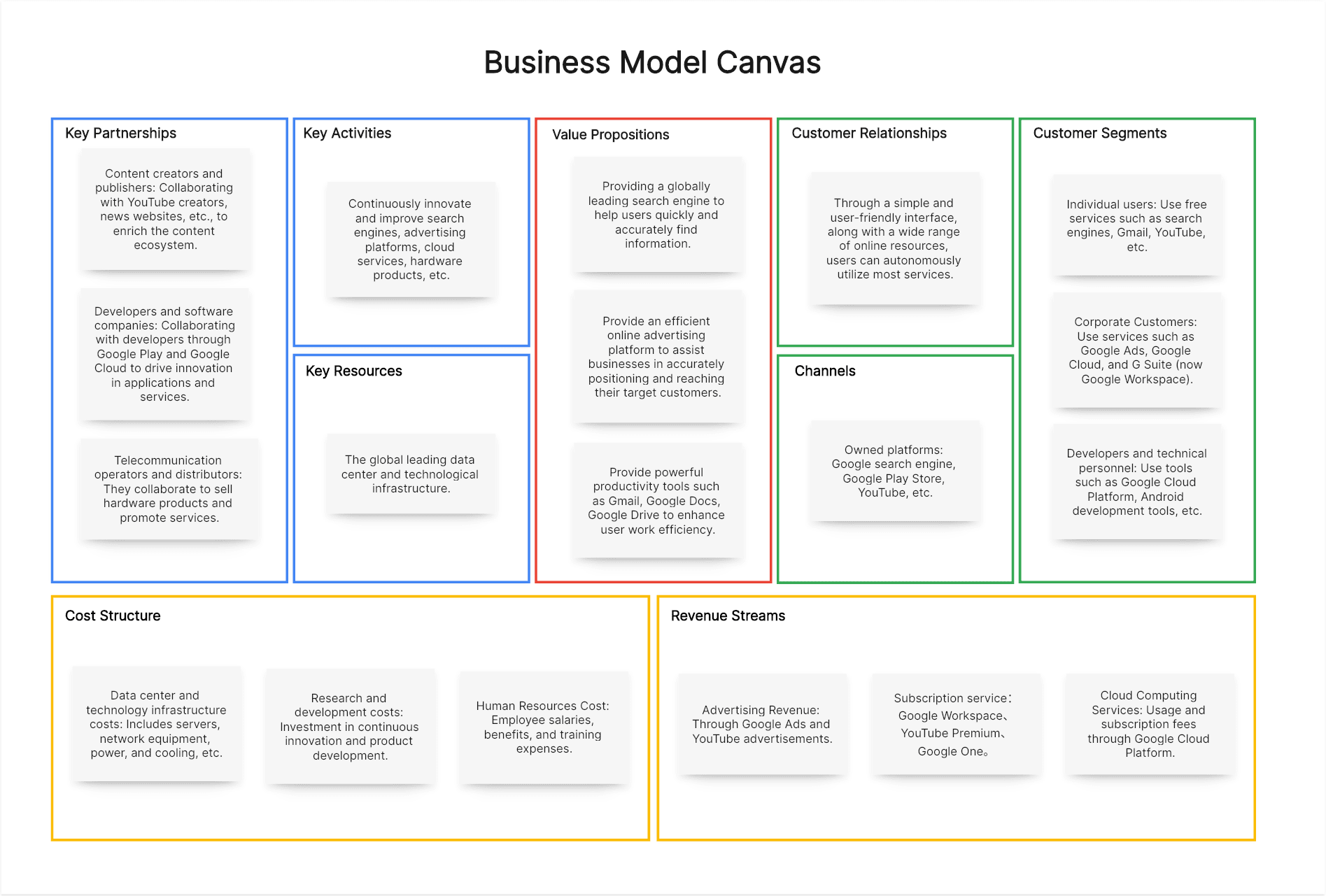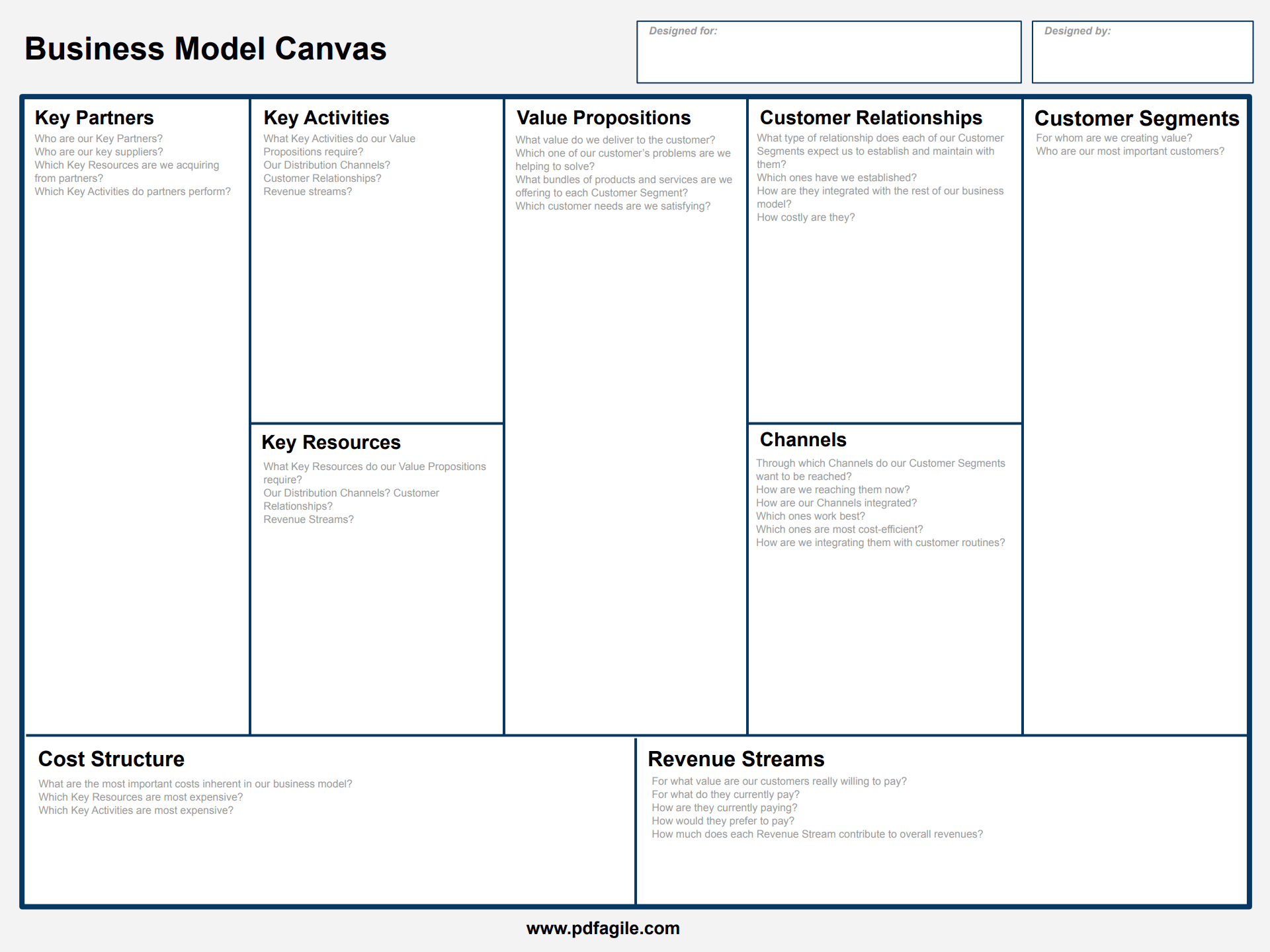Every successful business starts with a solid foundation. For many entrepreneurs, the Business Model Canvas serves as that foundational framework. This powerful tool allows you to visualize, brainstorm, and refine your business concept in a clear and concise way.
What is a Business Model Canvas?
The Business Model Canvas is a visual tool created by Alexander Osterwalder and Yves Pigneur. It consists of nine building blocks that represent the core elements of any business model. By filling out these blocks, you can gain a comprehensive understanding of how your business will create, deliver, and capture value.
When to Use a Business Model Canvas?
The Business Model Canvas is a versatile tool that can be applied at various stages of your entrepreneurial journey. Whether you're just starting out or looking to revitalize an existing business, this framework can provide valuable insights and strategic guidance.
- Startup Phase: When you're in the early stages of developing your business idea, the Business Model Canvas can help you crystallize your concept. By filling out the nine building blocks, you can identify potential challenges and opportunities, ensuring a solid foundation for your venture.
- Existing Business: Even if you've been operating your business for some time, the Business Model Canvas can be a powerful tool for assessing your current strategy. By revisiting the nine building blocks, you can identify areas for improvement and uncover new growth opportunities. Perhaps you're considering expanding into a new market or launching a new product line. The Canvas can help you evaluate the feasibility and potential impact of these initiatives.
- Innovation: In today's fast-paced business environment, innovation is key to staying ahead of the competition. The Business Model Canvas can be a valuable tool for generating new ideas and exploring innovative business models. By experimenting with different combinations of value propositions, customer segments, and revenue streams, you can uncover disruptive opportunities.
- Team Communication: A well-defined business model is essential for aligning your team and ensuring everyone is working towards a common goal. The Business Model Canvas provides a visual representation of your business strategy, making it easier for team members to understand their roles and responsibilities. By using the Canvas as a collaborative tool, you can foster open communication and encourage creative thinking.
Benefits of Using a Business Model Canvas
The Business Model Canvas offers a multitude of benefits for entrepreneurs and businesses of all sizes:
- Clarity and Focus: By breaking down your business model into its core components, the Canvas helps you gain a clear and focused understanding of your business. It can be easy to get lost in the details of your business plan, but the Canvas forces you to prioritize the most important aspects of your strategy.
- Improved Communication: The visual nature of the Canvas makes it easy to communicate your business model to others, whether they're team members, investors, or potential partners. By using a shared language and framework, you can ensure everyone is on the same page.
- Efficient Planning: The Canvas provides a structured approach to business planning, helping you avoid information overload and focus on the key elements of your strategy. By filling out the nine building blocks, you can quickly identify potential gaps and inconsistencies in your business model.
- Enhanced Innovation: The Canvas encourages creativity and innovation by prompting you to think outside the box. By challenging your assumptions and exploring different possibilities, you can discover new opportunities for growth and differentiation.
How to Use the Business Model Canvas Template
The Business Model Canvas is a versatile tool that can be used in various ways. Here's a step-by-step guide on how to effectively utilize this powerful framework:
- Gather Your Team: Bring together key stakeholders, including team members, investors, or advisors. Collaboration is key to a successful business model.
- Start with a Blank Canvas: Begin with a blank Business Model Canvas template. This will allow you to start fresh and avoid preconceived notions.
- Brainstorm and Fill in the Blocks:
- Customer Segments: Identify your target customers based on demographics, psychographics, or behavioral patterns. Consider creating customer personas to gain deeper insights.
- Value Propositions: Determine the unique value you offer to your customers. What problem does your product or service solve? What benefits does it provide?
- Channels: Identify the channels through which you will deliver your value proposition. This could include direct sales, e-commerce, retail partnerships, or digital marketing.
- Customer Relationships: Define the type of relationship you want to build with your customers. Will it be personal, automated, or a combination of both?
- Revenue Streams: Identify the primary sources of revenue for your business. This could include sales, subscriptions, licensing fees, or advertising.
- Key Resources: Determine the essential resources needed to deliver your value proposition. These could include physical assets, intellectual property, human capital, or financial resources.
- Key Activities: Identify the core activities that are crucial to your business model. This might involve product development, marketing, sales, or customer service.
- Key Partnerships: Identify any strategic partnerships that are essential to your business. These could include suppliers, distributors, or technology partners.
- Cost Structure: Analyze the costs associated with operating your business. This includes fixed costs, variable costs, and external costs.
- Iterate and Refine: Once you've filled in the initial blocks, review and refine your business model. Are there any inconsistencies or gaps? Are there opportunities to improve your value proposition or reduce costs?
- Use the Canvas as a Living Document: As your business evolves, so too should your business model. Regularly revisit and update your Canvas to ensure it remains relevant and effective.

Business Model Canvas Template FAQs
Q: What is the difference between a Business Model Canvas and a Lean Canvas?
A: While both tools are used to visualize and analyze business models, they have key differences. The Business Model Canvas provides a comprehensive overview of nine building blocks, including customer segments, value propositions, channels, and revenue streams. The Lean Canvas, on the other hand, is a simplified version focused on problem, solution, value proposition, customer segments, unfair advantage, channels, revenue streams, cost structure, and metrics. The Lean Canvas is often used in early-stage startups to quickly validate ideas and iterate on the business model.
Q: How does the Business Model Canvas differ from a business plan?
A: The Business Model Canvas offers a visual and concise snapshot of your business, while a traditional business plan is a more detailed and comprehensive document. However, the Canvas can be a valuable starting point for developing your business plan.
Q: Can I use the Business Model Canvas for a non-profit organization?
A: Absolutely! The Business Model Canvas is a versatile tool that can be applied to any type of organization, including non-profits. By adapting the nine building blocks to fit your specific goals and mission, you can create a sustainable and impactful business model.
Q: How often should I revisit and update my Business Model Canvas?
A: The frequency of revisiting your Business Model Canvas depends on the stage of your business and the rate of change in your industry. However, it's generally recommended to review and update your Canvas at least once a year. As your business evolves, so too should your business model.
Q: Can I use the Business Model Canvas for personal projects?
A: While the Business Model Canvas is primarily used for business ventures, it can also be applied to personal projects. By thinking about your personal goals, target audience, and revenue streams, you can use the Canvas to develop a more structured and focused approach to your projects.






